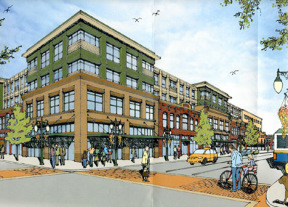Redevelop. Rejuvenate. Or leave it alone.
Those are the options that the Tacoma City Council and Mayor Bill Baarsma face regarding development of a half-block commercial strip located in the citys Hilltop neighborhood, according to discussion during a study session Aug. 30 at City Hall.
At issue is a decision to develop city-owned property along Martin Luther King, Jr. Way (MLK), and buy three adjacent parcels for $800,000 before their purchase agreements expire at the end of this month.
The move would propel the so-called Hilltop Renaissance Project — a plan to facilitate development of the area near MLK as a mixed-use commercial and residential corridor.
Still, concerns were raised Tuesday about purchasing the additional parcels.
Michael Trower of Catapult Community Developers, a Seattle-based consulting firm hired to assist the city in its decision, said that development of the city-owned property (or an assemblage of properties) wasnt feasible given the abundance of vacant leasable space in the neighborhood. Moreover, Trower said that development of a market demand in the Hilltop area would take up to five years, and require considerable effort from the city.
The community and the city need to undertake an aggressive marketing program to change the perception and reality of the neighborhood, said Trower. That said, he stressed that his assessment was purely financial, and the city should balance community development goals against the financial analysis.
To that end, Catapult met Aug. 8 and Aug. 25 with the public advisory created by the city council in order to gather the development goals for the Hilltop community. The advisory committee recommended that retail along the street should be focused on smaller community-based businesses, rather than a larger chain retail store, and the size and scale of existing properties is appropriate for the district.
The committee also agreed that a community development program is needed to change the public perception of the Hilltop neighborhood.
Whether or not the city decides to purchase the additional parcels or simply develop the property it already owns, Catapult offered four recommendations for managing these assets.
The do-nothing approach requires minimum outlay for expenses, and calls for the property to be minimally maintained, marginally functional, and partially or totally vacant for lack of interested tenants. This approach would not meet the citys standard for the properties it owns, nor would it meet the expectations of the neighborhood.
The paint-up/fix-up approach requires that the city incur additional costs for cosmetically improving the properties. Trower cautioned that this approach might be criticized as a Band-Aid approach. While some improvement will be welcomed by the community, he said, it may very well be regarded as not much better than maintaining the status quo.
The Rejuvenation approach calls for upgrades in the areas of finishes, quality, functionality, and appearance in order to make a difference in the look and feel of each property. However, if the costs associated with rejuvenation exceeds 60 percent of the value of the building, specific code requirements would categorize these improvements as redevelopment, according to Trower.
The redevelopment approach calls for the demolition of an existing structure, and construction of a new building. This approach would also require on-site parking — which this strip of properties presently lacks.
Historic preservation also needs to be considered in redevelopment of one or more of the buildings, according to findings from Catapult. Trower said the facades would need to be preserved in order to preserve historic significance.
Trower was clear about his concerns for market potential of these buildings.
In our opinion, there is not a private market for purchasing the properties at this time, he said. From the perspective of a private developer, absent a reasonably immediate market for new or rejuvenated development, there would be no interest in purchasing. From the perspective of a land speculator, there might be interest at a discounted price below assessed value for tax purposes.
Still, Councilmember Tom Stenger, who represents the Hilltop neighborhood, argued that many of those concerns were comparable to concerns regarding investment downtown. These concerns did not keep us from spending money on the convention center or the Carlton Building, said Stenger. They havent kept us from going ahead on other projects in other neighborhoods.
Mayor Baarsma agreed with Stenger, but added, We need to know what what the cons are.
The city-owned property, located at 1114 MLK, is the site of Brownes Star Grill, a restaurant and bar that has received mixed support from the Hilltop community. According to the city, the building was purchased in response to public outcry that the business was a magnet for criminal activity. Others argued that it was a longtime gathering place for Hilltops close-knit African American community.
The council approved an ordinance June 28 authorizing purchase of the property at 1114 MLK by using $600,000 in Urban Development Action Grant funds. The city is expected to provide a six-month extension of its lease with the owner of Brownes Star Grill, in order to provide a relocation opportunity.
According to Rick Brush, the citys asset manager, the three parcels were recently appraised at $800,000 ($340,000 for two adjacent properties to the north; $460,000 for an adjacent property to the south), and purchase agreements for $870,000 ($370,000 north; $500,000 south) are in place, but will expire Oct. 1. If the city wants to purchase the properties, it must approve an ordinance at the Sept. 20 city council meeting.








